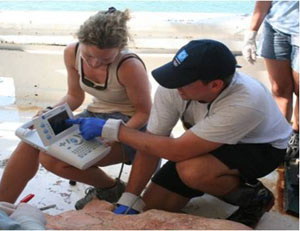Research - Reproductive studies
 Gaëlle Blanvillain and Dr. Tony Pease use ultrasound to examine the reproductive organs of an adult male loggerhead sea turtle captured by trawling in Port Canaveral, FL in April 2007.
Gaëlle Blanvillain and Dr. Tony Pease use ultrasound to examine the reproductive organs of an adult male loggerhead sea turtle captured by trawling in Port Canaveral, FL in April 2007.
Prior to 2006, testosterone radioim-munoassays to determine turtle sex constituted the extent of reproductive evaluations conducted for sea turtles captured by this research program. However, since 2006 a portable ultrasound has been available for imaging the reproductive organs of captured sea turtles. The capability of ultrasound to correctly identify internal structures in reproductively active and inactive adult male loggerhead sea turtles [34] was established [35] in April 2006 and 2007 when ultrasound was conducted in conjunction with laparoscopic evaluations.
Distinction of follicles and eggs is also feasible for reproductively mature females as well. However, identifying reproductive features among immature sea turtles using ultrasound remains challenging, and is therefore generally only attempted for loggerhead sea turtles >75.0 cm minimum straight-line carapace length. However, external evidence of male puberty (i.e., tail extension past the carapace) at smaller sized loggerhead sea turtles captured in recent years renders ultrasound an important field technique for in-water sea turtle captures in coming years. When coupled with expanded hormone analyses and morphometric studies, ultrasound could assist with refining estimates of size at maturity, particularly if annual catch rates for size classes historically associated with maturity for loggerhead sea turtles continue to increase significantly.
 A still-frame image of a sea turtle egg (nearly 2 in. in diameter) as recorded by ultrasound of an adult female loggerhead sea turtle captured by trawling in Port Canaveral, FL in April 2006.
A still-frame image of a sea turtle egg (nearly 2 in. in diameter) as recorded by ultrasound of an adult female loggerhead sea turtle captured by trawling in Port Canaveral, FL in April 2006.
34 Pease A, Blanvillain G, Rostal D, Owens D, Segars A. 2010. Ultrasound imaging of the inguinal region of adult male loggerhead sea turtles (Caretta caretta). J Zoo Wild Med 41(1):69-76.
35 Blanvillain G, Pease AP, Segars AL, Rostal DC, Richards AJ, Owens DW. 2008. Comparing methods for the assessment of reproductive activity in adult male loggerhead sea turtles Caretta caretta at Cape Canaveral, Florida. Endang Spec Res 6:75–85.
